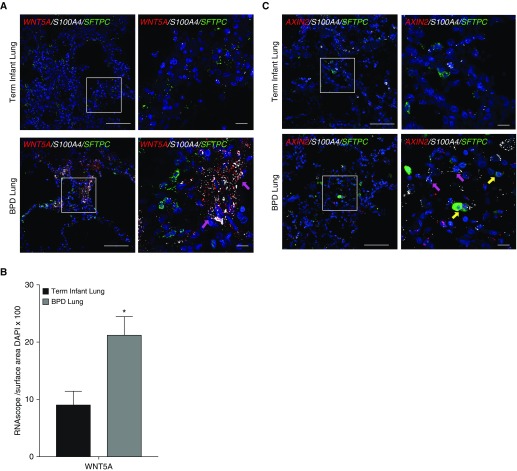Figure 6.
The pattern of mesenchymal expression of WNT5A is replicated in the lungs of human infants with bronchopulmonary dysplasia (BPD). (A) RNA in situ hybridization (RNA ISH) demonstrates increased expression of WNT5A (red) in lungs of infants who died with BPD (at >40 wk corrected gestational age at the time of death) when compared with term infants who died from nonrespiratory causes, with colocalization of WNT5A expression with expression of fibroblast marker S100A4 (white) indicated by magenta arrows, and no expression of WNT5A in cells coexpressing SFTPC. Scale bars, 100 μm. (B) Quantification of RNA ISH normalized to nuclear surface area shows significantly increased expression of WNT5A by BPD lung tissue when compared with term infant controls. *P < 0.05. (C) RNA ISH demonstrates increased expression of AXIN2 (red) in cells coexpressing S100A4 (magenta arrows) in lungs of infants who died with BPD (at >40 wk corrected gestational age at the time of death) when compared with term infants who died from nonrespiratory causes, with colocalization of WNT5A expression with expression of fibroblast marker S100A4 (white) indicated by magenta arrows, and coexpression of AXIN2 in cells coexpressing SFTPC (green) indicated by yellow arrows. Scale bars, 100 μm. White boxes in A and C denote inset area shown in higher magnification on the right. These data are representative of four infants who died with BPD at corrected gestational age 45–65 weeks and three term infant controls who died from nonrespiratory causes.

